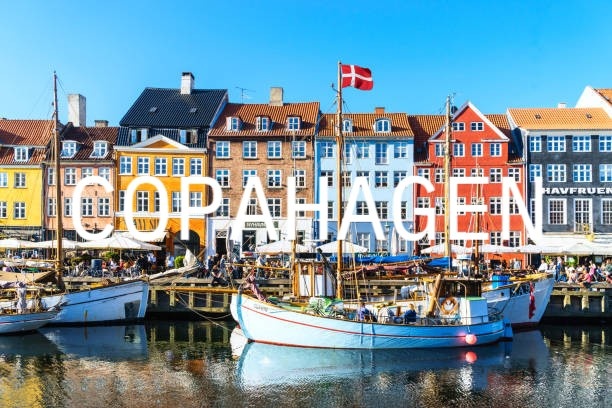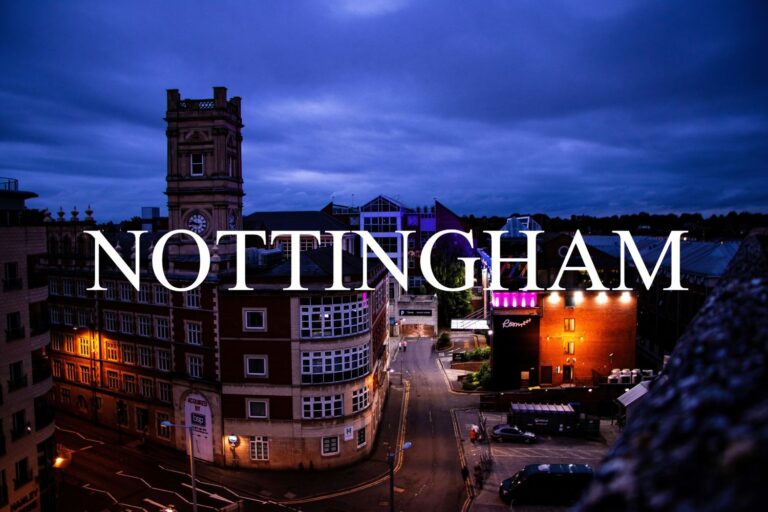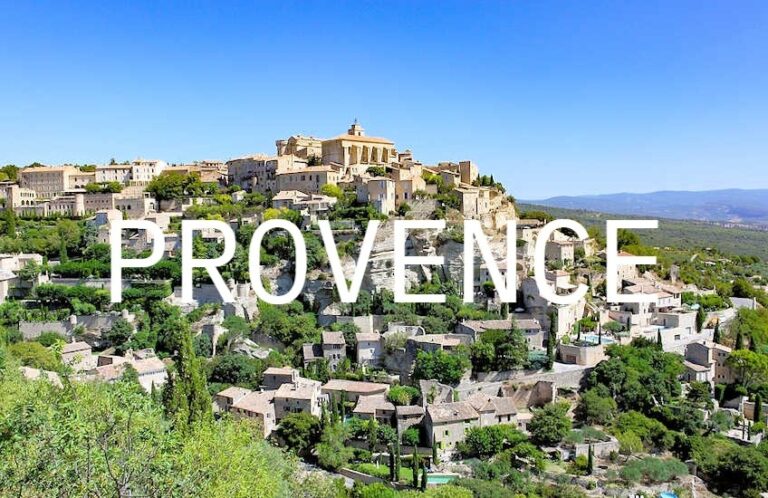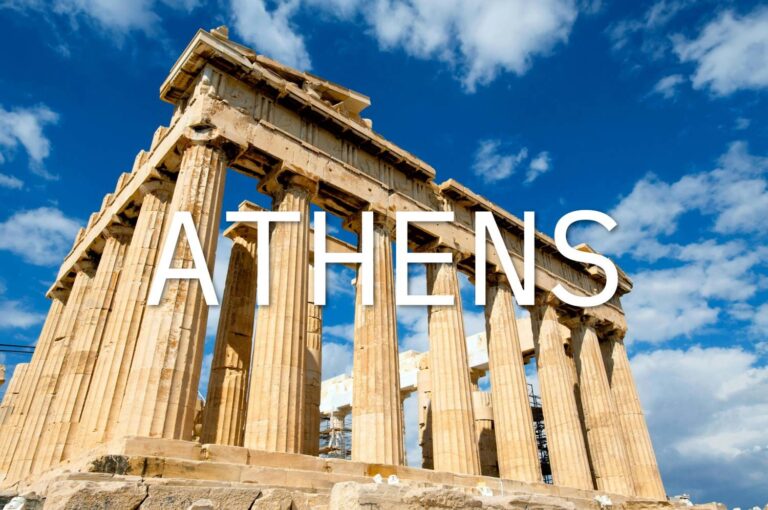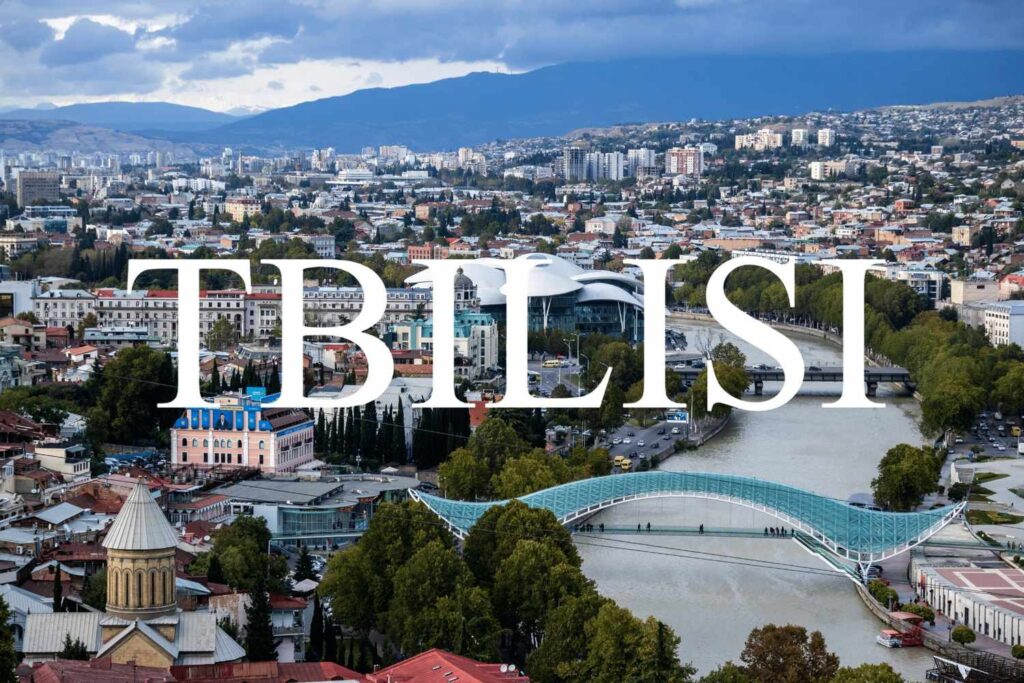
Nestled gracefully along the banks of the scenic Mtkvari River, Tbilisi, the vibrant capital of Georgia, is a city where ancient history meets a lively modern culture. With its winding cobblestone streets, striking old-world architecture, and a thriving arts scene, Tbilisi effortlessly captivates visitors from all walks of life.
Whether you’re strolling through the atmospheric Old Town with its charming balconies and historic churches, indulging in the rich flavors of Georgian cuisine, or exploring contemporary galleries and bustling markets, Tbilisi offers an authentic experience that feels both timeless and refreshingly new. Nature lovers will appreciate the breathtaking landscapes surrounding the city, from rolling hills to serene riverbanks.
For travelers who crave adventure, culture, or gastronomy, Tbilisi promises unforgettable memories at every corner. But to truly make the most of your visit, it’s important to know when the city shines brightest and which landmarks and neighborhoods you simply cannot miss.
In this guide, we’ll uncover the best places to visit in Tbilisi—from iconic sites like Narikala Fortress and the sulfur baths to hidden gems off the beaten path. We’ll also help you decide the best time to visit Tbilisi for perfect weather, festivals, and cultural events.
Best Places to Visit in Tbilisi
Narikala Fortress
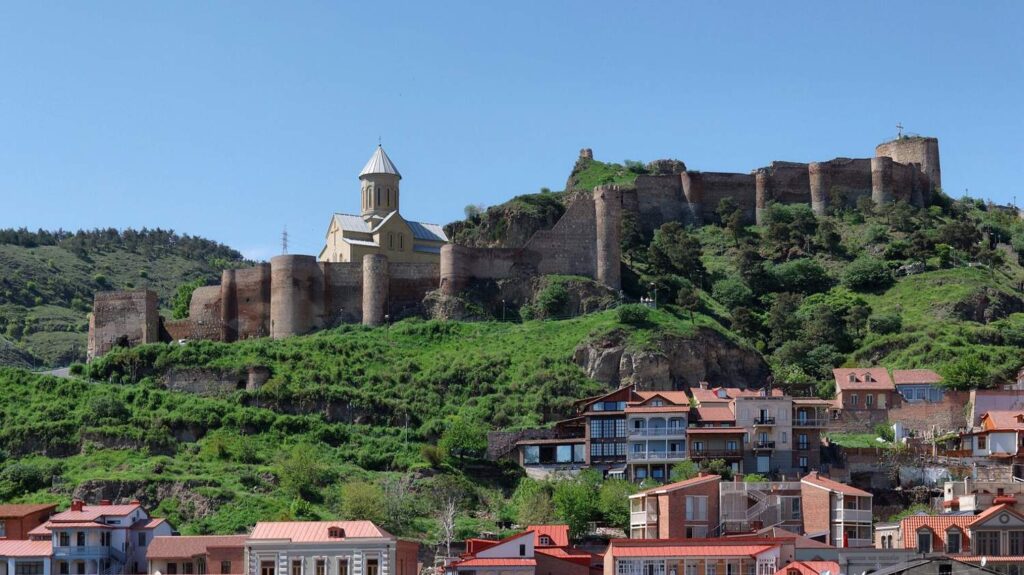
Perched on a hill overlooking the beautiful city of Tbilisi, Narikala Fortress is a centuries-old symbol of Georgia’s rich history and strategic significance. Offering panoramic views of the city, the fortress stands as a testament to the resilience of the city’s past, with influences dating back to ancient times. It has witnessed countless battles, invasions, and transformations, making it one of the must-see landmarks in Tbilisi.
🌟 Highlights of Narikala Fortress
• 🏰 Historical Significance
Narikala Fortress was founded in the 4th century by the Persians and later expanded by the Arabs in the 7th century. Over the centuries, it has played a central role in defending Tbilisi, withstanding invasions from various empires, including the Mongols and Russians. Today, it stands as a monument to Tbilisi’s enduring strength and heritage.
• 🌆 Breathtaking Views
The fortress offers spectacular views of Tbilisi and its surrounding landscapes, including the Kura River, the Old Town, and the iconic Sameba Cathedral. The vantage point from Narikala provides a perfect opportunity to capture Tbilisi’s unique blend of modern and historical architecture.
• 🏯 The Mother of Georgia Statue
Standing beside the fortress is the Mother of Georgia (or Kartlis Deda), a monumental statue symbolizing the country’s strength and hospitality. Holding a sword in one hand and a cup of wine in the other, the statue represents Georgia’s readiness to defend and welcome visitors alike.
• ⛪ St. Nicholas Church
Inside the Narikala Fortress complex lies the charming St. Nicholas Church. This small but significant church is a serene space, offering a peaceful retreat for visitors and a unique glimpse into the religious history of the region.
• 🛖 Ancient Architecture
The fortress is a blend of architectural styles, with remnants of ancient walls, towers, and gates alongside newer structures. The combination of Persian, Arabian, and Georgian influences gives Narikala its unique character, making it a fascinating spot for history lovers and photographers alike.
🚶 How to Get There
• By Foot:
Narikala Fortress is located on a hilltop in the heart of Tbilisi. The easiest way to get there is by walking from Old Town, which is just a 10-15 minute stroll. The walk up the hill can be steep, but it’s manageable for most visitors and offers a chance to explore the surrounding area.
• By Cable Car:
A popular and scenic way to reach Narikala Fortress is by taking the Tbilisi Cable Car from Rike Park near the Bridge of Peace. The cable car ride offers stunning views of Tbilisi and takes you directly to the fortress, making it a great option for those who want to skip the uphill climb.
• By Taxi:
Taxis in Tbilisi are affordable and can take you directly to the base of the fortress. If you’re short on time or prefer a more comfortable way to reach the top, this is a good option.
🕒 Visitor Information
• Best Time to Visit:
The best time to visit Narikala Fortress is during spring (April to June) and fall (September to November), when the weather is mild, and the views are clear. The fortress can get crowded in summer, especially during the tourist peak season, so visiting in the early morning or late afternoon offers a more peaceful experience.
• Opening Hours:
The fortress is open year-round, and there are no official closing times, as the site is largely open-air. However, St. Nicholas Church may have specific visiting hours, typically from 9:00 AM to 6:00 PM.
• Estimated Duration:
A visit to Narikala Fortress usually takes about 1–2 hours, depending on how much time you spend exploring the fortress, taking in the views, and visiting the church. If you’re taking the cable car, you can spend more time enjoying the area at your leisure.
💡 Travel Tips
• 🕰️ Best Time to Visit:
Visit in the morning or late afternoon to avoid crowds and to enjoy the soft light for photography, especially during sunrise or sunset.
• 📸 What to Bring:
Comfortable shoes for walking up the hill if you plan to hike to the fortress.
A camera to capture the stunning views of Tbilisi from above, particularly the panoramic vistas from the fortress walls.
Water and snacks if you plan to spend a longer time exploring the area.
🌡️ Weather Considerations:
The weather in Tbilisi can be hot in summer, so make sure to wear sunscreen and carry a hat or umbrella to protect yourself from the sun. In winter, the fortress can get chilly, so warm clothing is recommended.
• 🚶♀️ Hiking Option:
If you prefer a more active way to explore, consider hiking the trail that leads from the Old Town to Narikala Fortress. The path takes you through charming streets and offers plenty of opportunities for photos along the way.
Narikala Fortress is a must-visit for anyone exploring Tbilisi. Its historical significance, stunning vistas, and peaceful atmosphere make it one of the most iconic landmarks in Georgia. Whether you’re walking up to the fortress, taking a cable car ride, or admiring the Mother of Georgia statue, a visit to Narikala offers a perfect blend of history, nature, and culture.
Tbilisi Old Town (Altstadt)
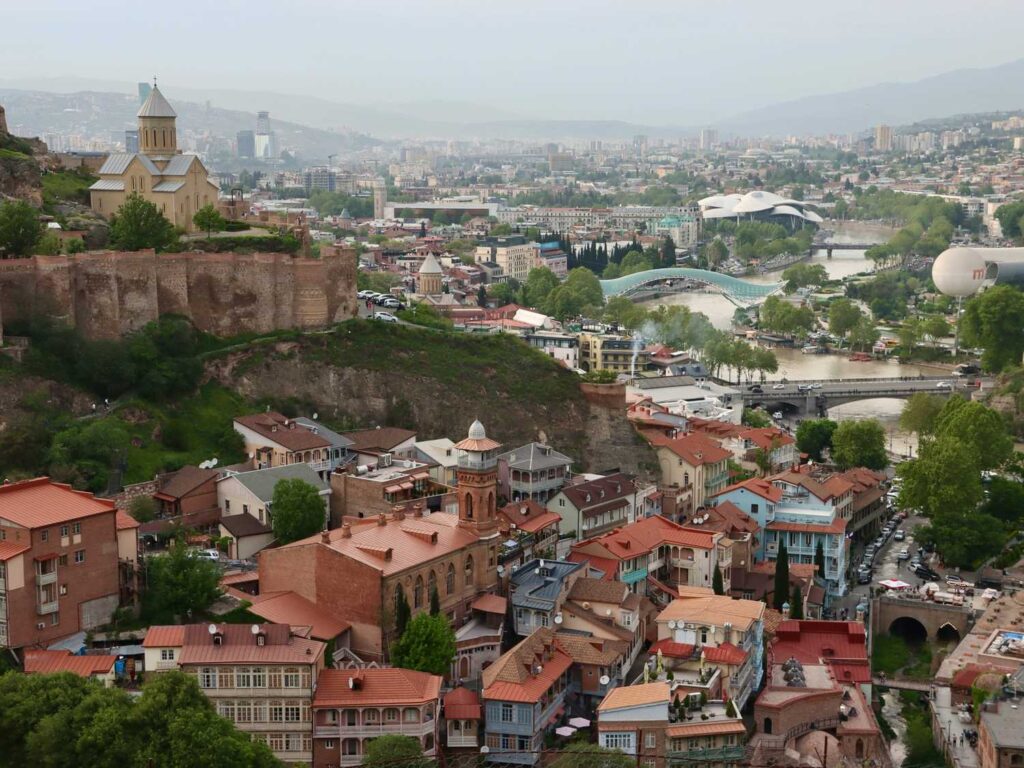
Tbilisi’s Old Town, or Altstadt, is a living testament to the city’s history, offering a unique blend of Georgian, Persian, Russian, and European influences. With its narrow cobblestone streets, colorful houses, hidden courtyards, and ancient churches, this area is the soul of Tbilisi, offering visitors an unforgettable glimpse into the past while living vibrantly in the present.
🌟 Highlights of Tbilisi Old Town (Altstadt)
• 🏰 Narikala Fortress
Sitting proudly above the Old Town, Narikala Fortress offers the best panoramic views of Tbilisi. A visit to the fortress provides a perfect starting point to explore the labyrinthine streets of Altstadt. You can easily walk or take a cable car to the fortress for a chance to admire the city from above.
• 🛁 Abanotubani (Sulphur Baths)
The famous sulphur baths of Abanotubani are one of Tbilisi’s oldest and most cherished features. With their therapeutic hot springs, visitors can unwind in the historic bathhouses that have been used for centuries. These baths also serve as a reminder of the Persian influence on Tbilisi’s architecture.
• ⛪ Sioni Cathedral
Sioni Cathedral is one of Tbilisi’s oldest and most important churches, dating back to the 6th century. The cathedral has been rebuilt and renovated several times over the centuries but retains its medieval charm. Don’t miss its stunning interior and beautiful frescoes, making it a must-see stop in the Old Town.
• 🏡 Tbilisi’s Colorful Houses
Wander through the winding streets of Old Town and admire the vibrantly painted houses, balconies, and intricate woodwork that line the streets. The mix of Georgian, Russian, and Persian-style architecture gives the area a distinctive charm.
• 🖼️ Tbilisi History Museum
Located in a historic building, the Tbilisi History Museum showcases the rich history of the city, from its ancient origins to its transformation through the centuries. With artifacts, photographs, and exhibitions, it’s a fascinating place to learn more about Tbilisi’s past.
• 🍇 Sharden Street
Sharden Street is the heart of Tbilisi’s café culture. Lined with charming cafes, bars, and restaurants, this street is perfect for leisurely strolls and people-watching. In the evenings, it transforms into a lively area, with locals and tourists gathering to enjoy food, music, and conversation.
• 🌉 The Bridge of Peace
Spanning the Kura River, the Bridge of Peace is a striking modern architectural marvel that contrasts beautifully with the ancient stone buildings of the Old Town. With its glass canopy and illuminated design, the bridge is a popular spot for photos, offering stunning views of Tbilisi’s skyline.
🚶 How to Get There
• By Foot:
Tbilisi Old Town is located in the heart of the city and is easily accessible by foot from almost any part of Tbilisi. Most of the major attractions are within walking distance of each other, making it a perfect area to explore on foot.
• By Taxi:
Taxis are readily available in Tbilisi and are a convenient option if you’re coming from other parts of the city. Simply ask for “Old Town,” and the driver will take you to the central areas.
• By Cable Car:
If you’re starting your tour at Narikala Fortress, you can take the Tbilisi Cable Car from Rike Park to the top of the hill, offering breathtaking views of the Old Town.
🕒 Visitor Information
• Best Time to Visit:
The best time to explore Tbilisi Old Town is during the spring (April to June) or autumn (September to November), when the weather is mild and the city is less crowded. Summer can be quite hot, and winter, although magical, can be chilly and snowy.
• Opening Hours:
The Old Town itself is open year-round. However, individual attractions like Sioni Cathedral and the Sulphur Baths may have specific visiting hours, typically from 9:00 AM to 6:00 PM.
• Estimated Duration:
A leisurely visit to Tbilisi Old Town can take 2–3 hours, but if you plan to visit several attractions like the churches, museums, or sulphur baths, you might want to allocate half a day for a deeper exploration.
💡 Travel Tips
• 🕰️ Best Time to Visit:
Morning or late afternoon is the best time to explore Old Town, especially if you want to avoid crowds. Early evenings also offer a magical atmosphere as the city begins to light up.
• 📸 What to Bring:
- Comfortable shoes for walking, as the cobblestone streets can be uneven.
- A camera to capture the charming streets, balconies, and panoramic views of the city.
- A hat or umbrella for sunny or rainy days, as the weather in Tbilisi can be unpredictable
• 🌡️ Weather Considerations:
The weather can get hot in the summer months, so carry water and stay hydrated. In winter, wear warm clothing, especially if you’re planning to visit outdoor spots like the Sulphur Baths.
• 🗣️ Language:
While Georgian is the official language, many people in the Old Town, especially in the tourist areas, speak some level of Russian and English.
Tbilisi’s Old Town (Altstadt) is a true gem that offers a fascinating blend of history, culture, and Georgian charm. Whether you’re wandering through the narrow streets, soaking in the views from Narikala Fortress, or relaxing in the sulphur baths, the Old Town provides a perfect snapshot of Tbilisi’s vibrant past and present. It’s a place where every corner tells a story, and every building is a piece of the city’s rich cultural heritage.
Holy Trinity Cathedral (Sameba)
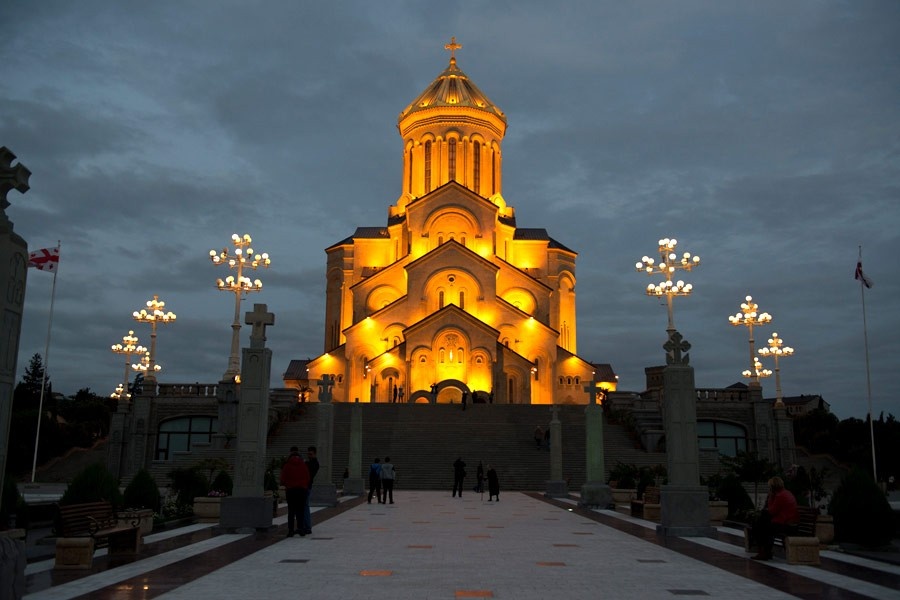
Rising gracefully above Tbilisi’s skyline, the Holy Trinity Cathedral of Tbilisi, better known as Sameba, is the largest and most impressive religious structure in Georgia. A symbol of the country’s spiritual and cultural rebirth after independence, Sameba combines traditional Georgian architectural styles with modern elements to create a striking landmark. It’s not just a place of worship but also a powerful statement of Georgia’s resilience and religious heritage.
🌟 Highlights of Holy Trinity Cathedral (Sameba)
• 🏰 Architectural Grandeur
Standing at 105 meters (344 feet) tall, Sameba is one of the tallest Orthodox churches in the world. Its construction, completed in 2004, beautifully blends ancient Georgian, Byzantine, and Armenian architectural styles. The cathedral features a massive dome, three-tiered design, and intricate stone carvings, making it an architectural marvel.
• 🕊️ Spiritual Significance
Sameba is not only the seat of the Georgian Patriarch but also a symbol of Georgia’s deep Orthodox Christian roots. Visitors can attend divine liturgies and religious ceremonies that provide insight into the spiritual life of the country. The cathedral plays a central role in religious and national celebrations.
• 🌿 Vast Complex
The Sameba complex is expansive, with the cathedral at its core, surrounded by beautifully landscaped gardens, smaller chapels, and a bell tower. The space exudes peace, and it’s a perfect spot for quiet reflection and exploration.
• 🖼️ Stunning Frescoes
Inside Sameba, you’ll find breathtaking frescoes depicting scenes from the Bible, saints, and Georgian religious history. The iconography is richly detailed and vibrant, adding to the cathedral’s solemn yet awe-inspiring atmosphere.
• 🏛️ The Crypt
Below the main floor, there’s a crypt that holds the remains of prominent religious figures. The crypt is a quieter area where visitors can feel the sacredness of the space and connect with Georgia’s religious past.
• 🌅 Panoramic Views of Tbilisi
Located on the hill of Elia Mountain, Sameba Cathedral offers some of the best panoramic views of Tbilisi, the Kura River, and the surrounding mountains. The sight of the city skyline with Sameba standing tall above is a perfect blend of modernity and tradition.
🚶 How to Get There
• By Foot:
Sameba is about a 20-minute walk from Tbilisi’s Old Town and Narikala Fortress. It’s situated on Elia Hill, and while the walk up can be steep, the views along the way are worth it.
• By Taxi:
Taxis are a quick and convenient way to reach Sameba. You can easily catch one from Rustaveli Avenue or the Old Town, and the ride will take approximately 5-10 minutes.
• By Bus:
Several local buses and minibuses have stops near Sameba. It’s best to ask locals for the nearest stops, as the cathedral is a well-known landmark in the city.
🕒 Visitor Information
• Best Time to Visit:
The best time to visit Sameba is during the morning or early afternoon to experience the peaceful atmosphere and avoid large crowds. Sunset is also a great time to visit, as the cathedral is illuminated, and the views of the city at golden hour are breathtaking.
• Opening Hours:
The cathedral is open daily, and there are no specific hours for visitors. Religious services are held regularly, and it’s best to check the schedule if you wish to attend.
- Divine Services: 9:00 AM – 1:00 PM (typically).
- Evening Services: 6:00 PM – 7:30 PM.
• Entry Fees:
Free admission for visitors. However, donations are appreciated to help maintain the cathedral and its grounds.
• Estimated Duration:
A visit to Sameba typically takes around 30 minutes to 1 hour, depending on whether you’re exploring the interior, admiring the frescoes, or taking photos of the surroundings.
💡 Travel Tips
• 🕰️ Best Time to Visit:
Morning visits are ideal to enjoy a quieter experience. If you’re interested in attending a religious service, you can witness the grandeur of the cathedral during liturgies.
• 📸 What to Bring:
- Comfortable shoes for walking, especially if you plan to walk up to the cathedral.
- A camera for capturing the breathtaking architecture, stunning frescoes, and panoramic views of Tbilisi.
- A headscarf or modest attire is recommended for women, as is customary for most Orthodox Christian churches.
• 🌡️ Weather Considerations:
Since Sameba is on a hill, it can get windy and cooler, especially in the evening. Bring a light jacket or sweater, particularly in the cooler months.
Holy Trinity Cathedral (Sameba) is more than just a place of worship—it’s a symbol of Georgian heritage, spiritual strength, and cultural pride. With its awe-inspiring architecture, peaceful atmosphere, and breathtaking views, it’s an essential stop for anyone visiting Tbilisi. Whether you’re interested in its history, architecture, or religious significance, Sameba offers a deeply moving experience that connects visitors to the heart of Georgia’s faith and traditions.
Mtatsminda Park
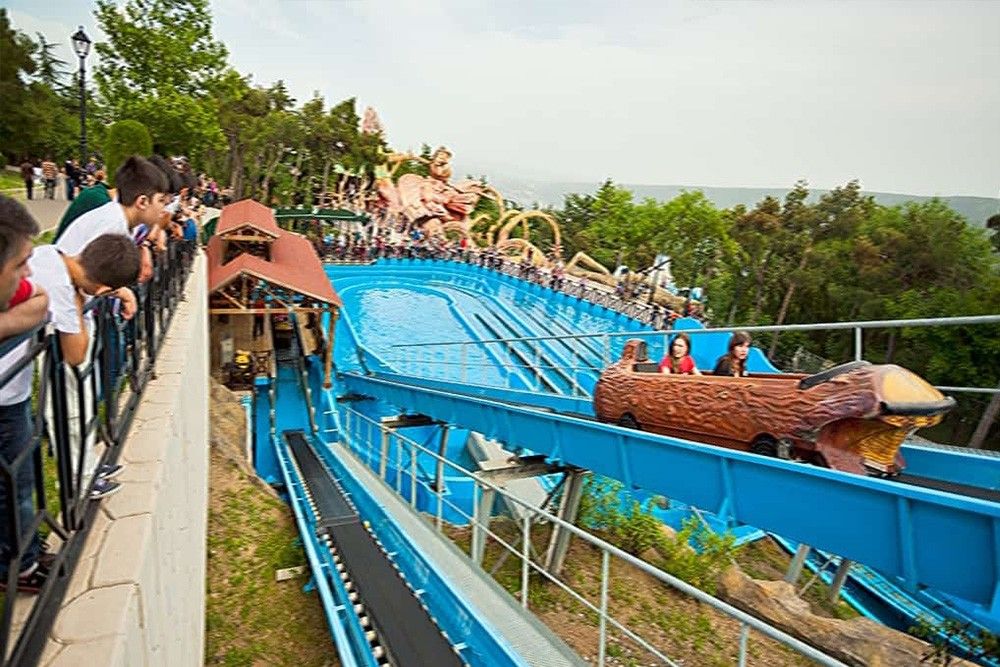
Perched high above Tbilisi on Mtatsminda Hill, Mtatsminda Park is an exciting blend of amusement, relaxation, and stunning vistas. Whether you’re seeking adventure at its theme park, a peaceful stroll through its scenic walkways, or simply a breathtaking view of the city, Mtatsminda Park has something for everyone. It’s a perfect escape from the hustle and bustle of Tbilisi, offering both locals and tourists a delightful mix of nature, entertainment, and spectacular views.
🌟 Highlights of Mtatsminda Park
• 🎠 Amusement Park
Mtatsminda Park offers a classic theme park experience with a wide range of rides and attractions. From roller coasters to carousel rides, it’s a great spot for families or anyone looking for a bit of adventure. Don’t miss the Ferris wheel, which offers the best panoramic views of the city.
• 🌿 Scenic Walks and Gardens
The park is set in a lush, green landscape with well-maintained gardens, wooded paths, and plenty of picnic spots. Whether you’re in the mood for a relaxing stroll or a peaceful spot to unwind, Mtatsminda Park provides plenty of opportunities to connect with nature and enjoy the fresh air.
• 🌅 Panoramic Views of Tbilisi
At the top of Mtatsminda Hill, the park offers some of the most spectacular views of Tbilisi. From here, you can see the Kura River, the iconic Sameba Cathedral, Narikala Fortress, and the sprawling cityscape stretching to the mountains beyond. It’s the perfect spot for photography, especially during sunset or at night when the city lights sparkle.
• 🎡 Mtatsminda Funicular
The Mtatsminda Funicular is a must-do experience. The funicular railway, which takes you from the city center to the park, is a fun way to reach the top while enjoying stunning views of the city along the way. It’s a scenic ride that adds an extra bit of adventure to your visit.
• 🍴 Cafes and Restaurants
Mtatsminda Park has several cafes and restaurants, perfect for enjoying a meal or a drink while taking in the incredible views. Whether you’re looking for a light snack or a full meal, there are options for every taste. In the evenings, many of these spots transform into lively venues where you can enjoy music and cocktails with friends.
• 🏰 The Mother of Georgia Statue
While not technically part of the park, the Mother of Georgia statue stands proudly at the top of Mtatsminda Hill. This iconic monument symbolizes Georgia’s strength and hospitality, offering a striking visual landmark that’s visible from many parts of the park.
🚶 How to Get There
• By Funicular:
The Mtatsminda Funicular is the easiest and most scenic way to reach the park. It departs from the Lower Station near Rustaveli Avenue. The ride offers beautiful views of Tbilisi and is a memorable experience in itself.
• By Taxi:
Taxis are readily available throughout Tbilisi and can take you directly to the entrance of the park. The ride will take around 15 minutes from Rustaveli Avenue.
• By Foot:
For those who are up for a bit of a climb, Mtatsminda Park is accessible by walking from Rustaveli or the Old Town. The walk is steep, but it’s a great way to enjoy the city’s landscape.
• By Car:
If you’re driving, there’s parking available at the park entrance, though it can get crowded during weekends or holidays.
🕒 Visitor Information
• Best Time to Visit:
Spring and autumn are the best times to visit Mtatsminda Park, with mild temperatures and beautiful scenery. In summer, the park provides a refreshing break from the heat of the city, and during winter, the park can be especially magical if it snows, offering a winter wonderland.
• Opening Hours:
- Park: Open daily from 9:00 AM to 10:00 PM.
- Funicular: The funicular runs from 9:00 AM to 11:00 PM, but timings may vary during peak seasons.
- Rides and Attractions: Typically open from 10:00 AM to 9:00 PM, with shorter hours in the winter months.
• Estimated Duration:
- 1 to 2 hours is enough to explore the park, enjoy the views, and take a ride on the funicular.
- If you plan to enjoy the rides, cafes, and take your time at the park, half a day is ideal.
💡 Travel Tips
• 🕰️ Best Time to Visit:
Early mornings or late afternoons offer the best weather and fewer crowds. Visiting at sunset is ideal for stunning views over the city.
• 📸 What to Bring:
- Comfortable shoes for walking if you plan to explore the park on foot.
- A camera for capturing the amazing views and the park’s attractions.
- Sunscreen and water in the summer months.
- 🐾 Pet-Friendly:
Mtatsminda Park is pet-friendly, so feel free to bring your dog or pet along for the adventure. Just make sure to keep them on a leash.
Mtatsminda Park is more than just an amusement park – it’s a place where you can enjoy nature, thrill rides, and some of the best views in Tbilisi. Whether you’re visiting for the fun of the rides, the serene beauty of the park, or the stunning panoramic views of the city, this spot is a must-see for anyone exploring Tbilisi. Perfect for families, couples, or solo travelers, Mtatsminda offers a refreshing break from the city’s hustle, all while giving you an unforgettable experience.
Sulphur Baths (Abanotubani)
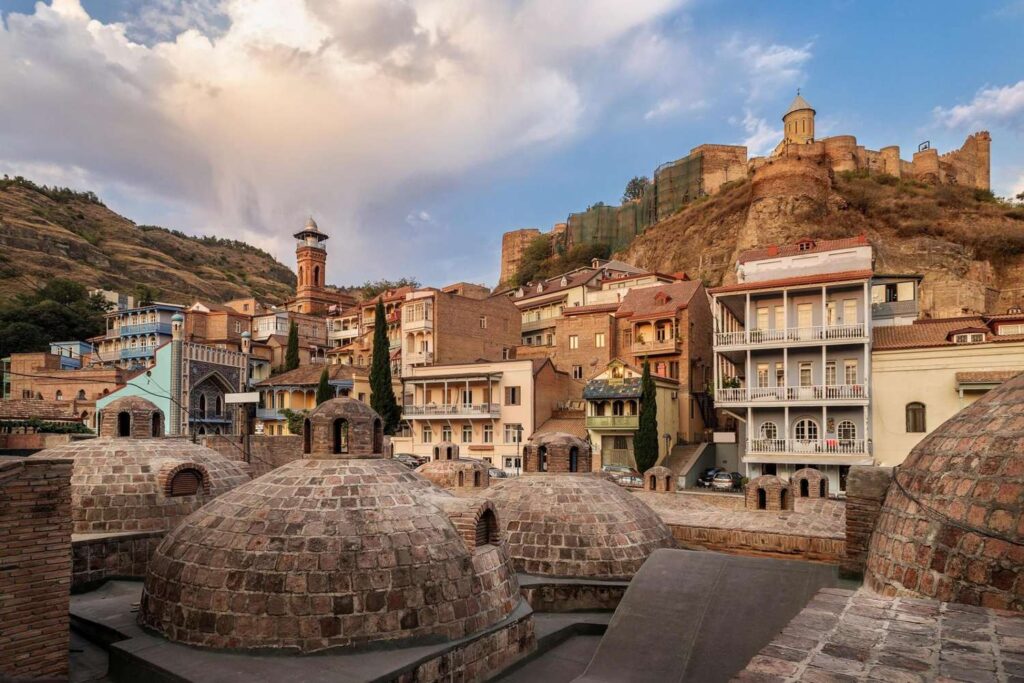
Nestled in the heart of Tbilisi’s historic Abanotubani district, the Sulphur Baths are not only a place to relax but also a gateway to the city’s ancient traditions. Known for their healing properties, these famous baths have been a part of Tbilisi’s culture for centuries. Whether you’re seeking relaxation, health benefits, or a deep dive into the city’s rich history, the Sulphur Baths offer a unique and rejuvenating experience that has stood the test of time.
🌟 Highlights of Sulphur Baths (Abanotubani)
• 💧 Natural Sulphur Springs
The baths are fed by natural sulphur springs, which are believed to have healing properties. The hot water, rich in minerals, is said to help with skin conditions, muscle relaxation, and general wellness. Bathing in these waters has been a tradition for centuries, making it an essential part of the city’s cultural fabric.
• 🏛️ Historic Charm
The Abanotubani district has been famous for its sulphur baths since the 5th century, and many of the current bathhouses are housed in traditional domed structures. The iconic brick domes that cover the bathhouses give the area its unique charm. Stepping inside is like entering a living piece of Tbilisi’s past, where the time-honored spa tradition continues.
• 🌿 Private and Public Bathing
The Sulphur Baths offer both private rooms for those seeking a more intimate experience and public baths where you can soak alongside other visitors. The private rooms are perfect for groups or those looking for a more personal experience, while the public baths provide a more communal, historic atmosphere.
• 💆 Traditional Spa Treatments
Many of the bathhouses offer additional services like massages, scrubs, and other wellness treatments to enhance your experience. Traditional Georgian scrubs (sometimes with herbs or honey) are a popular treat, leaving your skin feeling soft and rejuvenated.
• 🌞 Thermal Pools
The waters of the sulphur baths are heated naturally, and the pools vary in temperature. Some baths have hot tubs that allow you to fully unwind, while others are cooler and perfect for a refreshing dip.
• 🏙️ Vibrant Atmosphere
The sulphur baths are not just a place for relaxation but also a social gathering spot. Visitors often come together to share the experience, making the baths an interesting place to meet locals and fellow travelers while immersing yourself in the culture.
🚶 How to Get There
• By Foot:
The sulphur baths are located in the Abanotubani district, just a short walk from Tbilisi’s Old Town and Narikala Fortress. The cobblestone streets of this historic district are easily navigable, making it a pleasant stroll from the heart of the city.
• By Taxi:
Taxis are an easy and convenient way to reach the baths, especially if you’re coming from other parts of the city. A taxi ride from Rustaveli Avenue or Freedom Square takes around 5–10 minutes.
• By Public Transport:
There are bus and minibus routes that pass close to the Abanotubani district. You can check for the nearest stop by asking locals or at your hotel.
🕒 Visitor Information
• Best Time to Visit:
The Sulphur Baths are a year-round attraction, but the best time to visit is typically during milder months like spring or autumn when the weather is comfortable. The baths are especially relaxing during cold weather, providing a warm, cozy retreat.
• Estimated Duration:
A visit to the sulphur baths usually lasts around 1 to 2 hours, but if you plan on enjoying additional services like massages or spending time in a private room, you may want to set aside more time.
💡 Travel Tips
• 🕰️ Best Time to Visit:
The morning is a great time to visit for a quieter experience, especially if you prefer a more relaxing atmosphere without the crowds.
• 📸 What to Bring:
- Swimsuit: Most bathhouses provide towels and slippers, but bringing your own swimsuit is a good idea.
- Flip-flops or water shoes for walking around the wet areas.
- Cash: Most bathhouses accept cash payments, so be sure to carry Georgian Lari or credit cards.
• 🌡️ What to Expect:
The sulphur baths are hot, and the steam can be intense, so it’s essential to stay hydrated. Take breaks and enjoy the relaxation at your own pace.
The Sulphur Baths in Tbilisi are not just a relaxing experience—they’re a connection to the city’s ancient traditions and its rich cultural heritage. Whether you’re soaking in the mineral-rich waters for their therapeutic benefits or simply immersing yourself in the atmosphere of this centuries-old spa culture, a visit to Abanotubani is a must for anyone exploring Tbilisi. A blend of history, wellness, and social experience, the Sulphur Baths offer a unique way to experience the heart and soul of Georgia.
Rustaveli Avenue
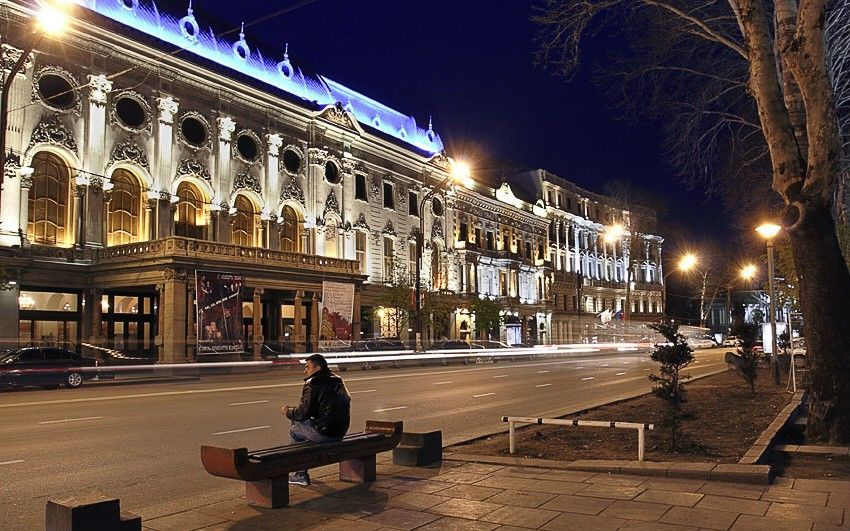
Stretching through the very heart of Tbilisi, Rustaveli Avenue is more than just a street—it’s a dynamic cultural and historical hub. Named after the famous Georgian poet Shota Rustaveli, this iconic thoroughfare is home to some of the city’s most significant landmarks, including theaters, museums, government buildings, and charming cafes. Whether you’re a history lover, culture enthusiast, or just someone looking to soak in the energy of Tbilisi, Rustaveli Avenue offers something for everyone.
🌟 Highlights of Rustaveli Avenue
• 🎭 Cultural Hub
Rustaveli Avenue is home to several of Tbilisi’s most important cultural institutions, such as the Georgian National Museum, the Tbilisi Opera House, and the Rustaveli Theatre. These venues host a variety of performances, from operas and ballets to theater plays, making the avenue a hotspot for cultural lovers.
• 🏛️ Architectural Beauty
The architecture along the avenue is a mix of neo-classical, Baroque, and Soviet-era buildings, creating an eclectic urban landscape. Notable structures include the Parliament of Georgia, the Tbilisi Opera House, and the National Library. Each building tells a story of Tbilisi’s rich past and evolving present.
• 🏙️ Bustling Atmosphere
Rustaveli Avenue is the place where locals and tourists alike gather to stroll, shop, and enjoy the city’s lively atmosphere. The avenue is lined with boutiques, cafes, and restaurants, offering a mix of modern flair and traditional Georgian charm. It’s a perfect place to grab a coffee, people-watch, or enjoy an outdoor meal while soaking in the vibrant energy of Tbilisi.
• 🏛️ Government Buildings
Along Rustaveli, you’ll also find some of Tbilisi’s most important government buildings, including the Parliament of Georgia. While some of these buildings may not be open to the public, their grand architecture and historical significance are worth admiring from the outside.
• 🏺 Historical Landmarks
As you walk along the avenue, you’ll encounter statues, monuments, and plaques that commemorate Georgia’s history and its great literary and political figures. For instance, you’ll find a statue of Shota Rustaveli, the namesake of the avenue, and a plaque dedicated to Georgia’s celebrated writers and poets.
🚶 How to Get There
• By Foot:
Rustaveli Avenue is easily accessible from most of the Old Town and is a pleasant walk from landmarks like Freedom Square and the Narikala Fortress. If you’re staying in or around the city center, walking along the avenue is a great way to experience Tbilisi.
• By Taxi:
Taxis are readily available throughout Tbilisi. Depending on your location, the ride to Rustaveli Avenue will take around 5–10 minutes from popular areas like Vake or Mtatsminda Hill.
• By Public Transport:
The avenue is well-served by buses and trolleybuses, and you can also access the Rustaveli Metro Station located directly beneath the avenue, making it convenient to get to from almost anywhere in the city.
🕒 Visitor Information
• Best Time to Visit:
Rustaveli Avenue is vibrant year-round, but spring and autumn are ideal for pleasant weather and clear skies. The avenue is especially lively during festivals, concerts, and public holidays, offering a festive atmosphere.
1–2 hours is a good amount of time to stroll along the avenue, admire the buildings, and stop for coffee or shopping. If you’re planning to visit museums or catch a performance, allocate more time accordingly.
💡 Travel Tips
• 🕰️ Best Time to Visit:
Early morning or late evening is the best time for a peaceful stroll, avoiding the midday crowds. However, if you want to experience the avenue’s full energy, the afternoon is lively with locals and tourists enjoying the cafes and shops.
• 📸 What to Bring:
- Comfortable walking shoes as Rustaveli Avenue is best explored on foot.
- A camera for capturing the avenue’s architectural beauty and bustling atmosphere.
- Sunscreen and water, especially in the warmer months.
🎟️ Don’t Miss:
- Stop by the National Museum of Georgia to explore Georgia’s history, art, and archeology.
- Attend a performance at the Tbilisi Opera House or the Rustaveli Theatre for an unforgettable cultural experience.
Rustaveli Avenue is truly the spine of Tbilisi, connecting culture, history, and daily life in a way that’s both modern and timeless. Whether you’re walking through its cultural landmarks, shopping in its boutiques, or simply enjoying a coffee at a sidewalk cafe, this iconic avenue offers a perfect snapshot of the vibrant energy that defines Georgia’s capital. For any traveler visiting Tbilisi, Rustaveli Avenue is the ideal starting point to immerse yourself in the city’s history, culture, and charm.
Tbilisi Botanical Garden
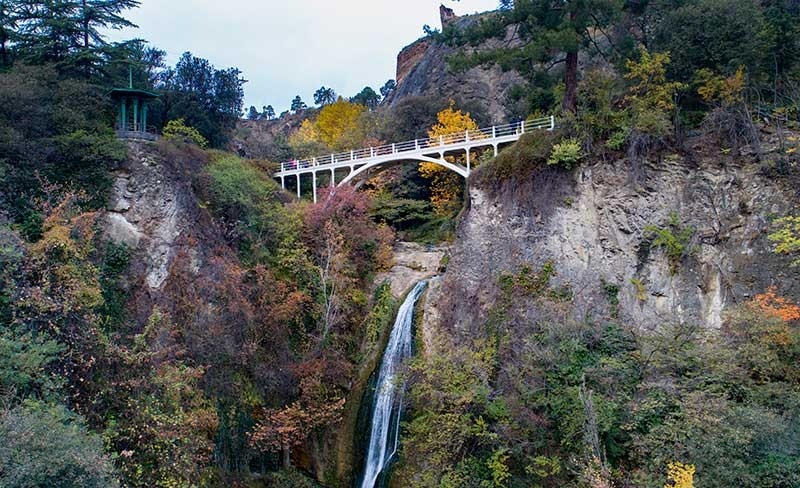
Nestled at the foot of Narikala Fortress, the Tbilisi Botanical Garden is a peaceful retreat in the middle of Georgia’s bustling capital. Covering 161 hectares, this lush, expansive garden offers a perfect escape from the urban rush. With its diverse plant species, flowing streams, and scenic walking trails, the garden is a sanctuary for nature lovers and a must-visit for anyone seeking tranquility in Tbilisi.
🌟 Highlights of Tbilisi Botanical Garden
• 🌸 Rich Flora
The garden boasts over 4,500 species of plants, including native Georgian flora and exotic plants from all over the world. The garden is divided into various sections, such as the medicinal plant garden, the Japanese garden, and the rose garden, each showcasing a different aspect of nature’s beauty. Whether you’re a botany enthusiast or simply enjoy a peaceful stroll, there’s something to marvel at around every corner.
• 💦 Waterfalls and Streams
One of the most captivating features of the garden is its series of natural waterfalls and mountain streams, which cascade through the landscape, adding a soothing sound of water to the atmosphere. These flowing waters create a tranquil environment perfect for relaxation, photography, and reflection.
• 🌳 Hiking Trails
The garden offers a variety of well-maintained walking and hiking trails, perfect for those who enjoy being active while surrounded by nature. Whether you want to take a leisurely walk or venture deeper into the park for a more adventurous hike, you’ll find plenty of paths to explore. The elevated trails also offer spectacular views of Tbilisi, the Kura River, and the surrounding hills.
• 🦋 Wildlife and Bird Watching
The garden is home to various wildlife, including birds, butterflies, and small mammals. Birdwatchers can enjoy spotting a wide range of species, especially in the more secluded areas of the park, where nature remains undisturbed.
• 🌺 Themed Gardens
Beyond its general plant collections, the Tbilisi Botanical Garden features unique areas like the Chinese Garden, the Caucasian Garden, and the Alpine Garden, each offering a glimpse into different ecosystems and design styles.
• 🏞️ Panoramic Views
From the higher points in the garden, you can enjoy stunning panoramic views of Tbilisi’s Old Town, Narikala Fortress, and the Kura River. The mountain backdrop adds a sense of serenity to the landscape, making it a favorite spot for photographers and nature lovers.
🚶 How to Get There
• By Foot:
The Tbilisi Botanical Garden is located in the heart of Tbilisi, just a short walk from Narikala Fortress and Rike Park. The walk through the cobblestone streets of the Old Town adds charm to the journey, and the garden’s entrance is at the base of Narikala Hill, making it easily accessible on foot.
• By Taxi:
Taxis are a convenient way to reach the garden, especially if you’re coming from other parts of the city like Rustaveli Avenue or Freedom Square. The ride should take around 5-10 minutes from most central locations in Tbilisi.
• By Cable Car:
The Tbilisi Cable Car station is located near Rike Park, and you can take a cable car to the Narikala Fortress. From there, it’s just a short walk to the garden entrance, making it a fun way to enjoy views of the city before reaching the lush garden below.
🕒 Visitor Information
• Best Time to Visit:
The garden is open year-round, but spring and autumn are the most popular seasons for a visit. In spring, the garden is in full bloom, while autumn brings beautiful fall foliage and cooler temperatures. The summer months can be warm, but the garden’s shaded paths and water features provide a refreshing escape.
• Estimated Duration:
Most visitors spend about 1.5 to 2 hours exploring the garden, but if you want to hike or enjoy the landscape in more detail, you can easily spend half a day in this lush haven.
💡 Travel Tips
• 🕰️ Best Time to Visit:
Early morning or late afternoon is the best time to visit if you prefer to avoid the crowds. Golden hour (just before sunset) provides the perfect lighting for photography, especially with the city views in the background.
• 📸 What to Bring:
- Comfortable walking shoes, especially if you plan to explore the hiking trails.
- Sunscreen and a hat, as it can get sunny during the warmer months.
- A camera for capturing the stunning nature and views of Tbilisi.
• 🧳 What to Expect:
- The garden can get steep in some areas, so be prepared for a bit of uphill walking, especially if you plan to explore the higher paths.
- Bring water to stay hydrated, especially if you’re planning to hike.
The Tbilisi Botanical Garden offers a perfect blend of nature, history, and peaceful retreat right in the center of Tbilisi. Whether you’re interested in exploring its diverse plant collections, taking a scenic hike, or simply enjoying the tranquil environment, the garden is a great spot to unwind and recharge. With its rich beauty and panoramic views of the city, it’s an oasis that provides a unique perspective on the Georgian capital. Whether you’re a nature lover, photographer, or just seeking some relaxation, the botanical garden is a must-visit in Tbilisi.
The Bridge of Peace
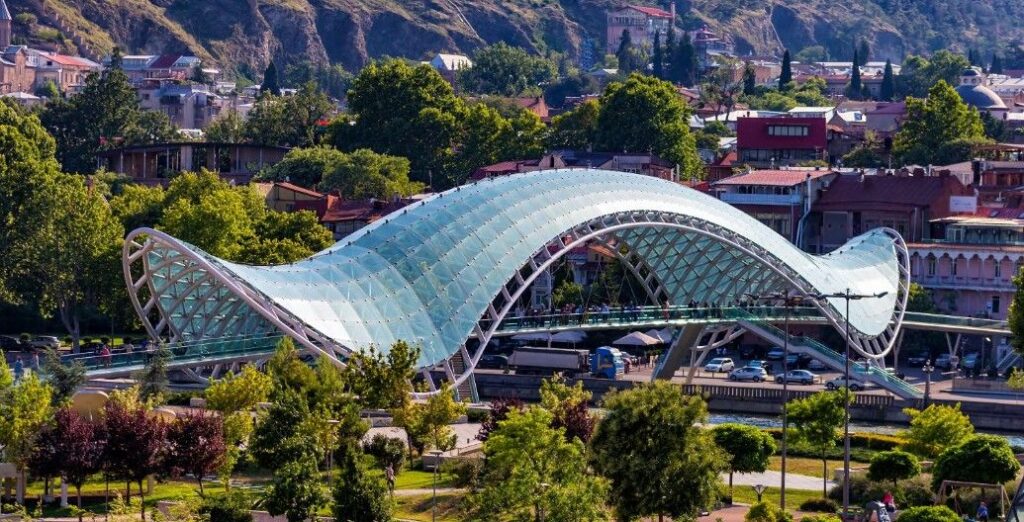
The Bridge of Peace is one of Tbilisi’s most striking landmarks, a futuristic pedestrian bridge that gracefully spans the Kura River. Completed in 2010, this stunning piece of modern architecture symbolizes Georgia’s journey towards unity, peace, and progress. Its sleek, curvilinear design, combined with a dazzling light display at night, makes it a favorite for both locals and visitors.
🌟 Highlights of the Bridge of Peace
• 🌙 Nighttime Light Show
The Bridge of Peace is especially captivating at night when its LED lighting system comes alive. The bridge illuminates in various colors, creating a mesmerizing effect that reflects off the Kura River and lights up the city skyline. It’s a must-see spectacle for anyone visiting Tbilisi after dark.
• 🏙️ Spectacular Views
From the bridge, visitors can enjoy panoramic views of Tbilisi, including the Old Town, the Narikala Fortress, and the Mtatsminda Mountain. The bridge’s central location also offers a great vantage point of the Kura River flowing through the heart of the city.
• 🏛️ Architectural Design
Designed by Italian architect Michele De Lucchi, the bridge’s metal lattice structure creates a flowing, organic shape that contrasts beautifully with the historic buildings nearby. Its innovative design and use of glass and steel make it one of the most recognizable structures in Tbilisi.
• 🚶 Pedestrian-Only Access
The bridge is exclusively for pedestrians, making it a peaceful space to stroll across. It’s also equipped with wide walkways, benches, and glass panels offering clear views of the surrounding cityscape and river, making it a serene spot to sit, relax, and enjoy the surroundings.
🚶 How to Get There
• By Foot:
The Bridge of Peace is located in central Tbilisi, close to Rike Park and Freedom Square. It’s a pleasant walk from the Old Town and easily accessible from nearby landmarks like the Narikala Fortress and Metekhi Church.
• By Taxi:
Taxis are available throughout Tbilisi. The ride to the bridge will take only about 5 minutes from popular areas like Rustaveli Avenue.
• By Cable Car:
The Tbilisi Cable Car drops you off near Rike Park, from where it’s a short walk to the bridge. The ride offers a great opportunity to see Tbilisi from above before reaching the bridge below.
🕒 Visitor Information
• Best Time to Visit:
The Bridge of Peace is stunning at any time of day, but the best time to visit is during the evening when the bridge’s lights create a dramatic effect. For the best photos, visit around sunset or during nighttime.
• Opening Hours:
The bridge is open 24/7, as it is a public pedestrian bridge. However, the surrounding Rike Park is typically open from 9:00 AM to 10:00 PM, providing a great place to relax before or after crossing the bridge.
• Estimated Duration:
You can cross the bridge in about 10–15 minutes, but take your time to enjoy the views and snap photos. Allocate around 30 minutes to 1 hour to fully appreciate the area and the surroundings.
💡 Travel Tips
• 🕰️ Best Time to Visit:
For the best views and atmosphere, plan to visit in the evening when the bridge’s lights illuminate the city. The bridge is less crowded early in the morning, making it a peaceful time for photos.
• 📸 What to Bring:
- Comfortable walking shoes, as you’ll likely want to walk around the surrounding area.
- A camera for capturing the incredible architecture and stunning river views.
- A smartphone if you’re interested in taking pictures of the changing lights at night.
• 🧳 What to Expect:
The bridge is a pedestrian-only zone, so expect a quiet, relaxed atmosphere. Be prepared for some light crowds in the evenings when locals and tourists gather to enjoy the light show.
The Bridge of Peace is more than just a modern structure; it’s a symbol of connection and unity for the city of Tbilisi. With its breathtaking design, spectacular light shows, and panoramic views, it’s a must-visit for anyone traveling to the Georgian capital. Whether you’re crossing the bridge during the day or watching it light up at night, this architectural marvel is a fantastic way to experience Tbilisi’s blend of old and new.
Fabrika
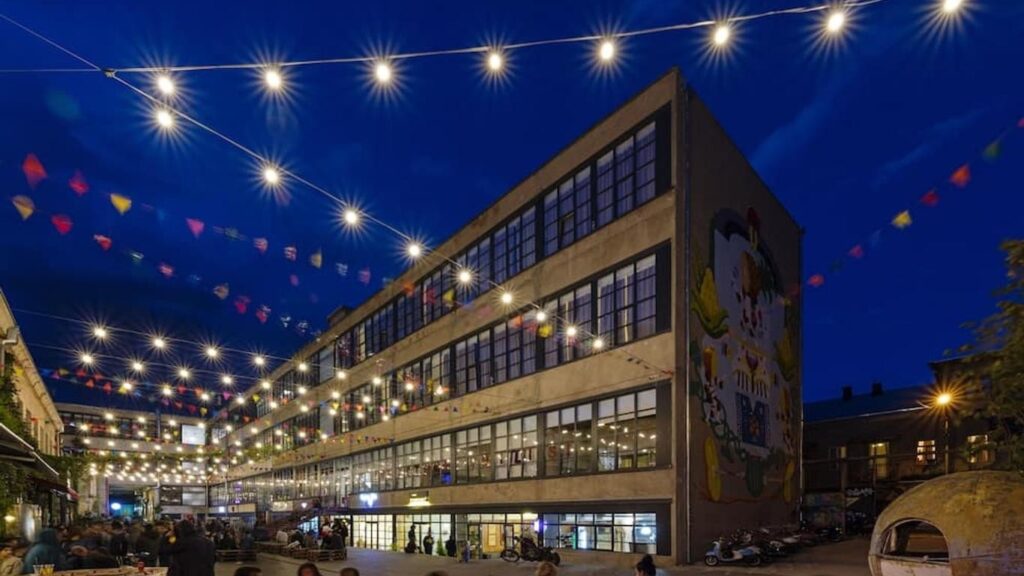
Located in a former Soviet sewing factory, Fabrika has transformed into one of Tbilisi’s most vibrant and eclectic spaces. This multi-functional venue is now a haven for creatives, offering a mix of art, culture, food, and nightlife. It’s a place where the old industrial charm of Tbilisi meets the modern energy of its youth and artistic communities.
🌟 Highlights of Fabrika
• 🖼️ Art and Creativity
Fabrika is home to several art galleries, workshops, and exhibition spaces. Local artists and international creators regularly showcase their work here, from contemporary art to experimental installations. Whether you’re an art lover or just appreciate the creative atmosphere, there’s always something inspiring to see.
• 🍕 Food and Drink
With a variety of cafés, restaurants, and bars, Fabrika offers a range of culinary delights, from casual bites to more sophisticated fare. Whether you’re in the mood for a coffee, craft beer, or a traditional Georgian meal, you’ll find something to suit your tastes. The on-site pizza places are particularly popular among locals and visitors alike.
• 🎶 Live Music and Events
As the sun sets, Fabrika comes alive with live music, DJ sets, and events. The venue has become one of the city’s top spots for nightlife, with regular performances by local musicians and international acts. It’s the perfect place to unwind with friends and enjoy some drinks while taking in the lively atmosphere.
• 💻 Co-working Spaces
Fabrika also hosts co-working spaces, making it a favorite among freelancers, digital nomads, and entrepreneurs. The shared workspaces foster collaboration and creativity, and the environment is buzzing with energy. It’s a place where ideas come to life, and collaborations happen organically.
• 🛍️ Boutiques and Shops
The space is home to boutiques and concept stores selling everything from handmade crafts to vintage clothing and local design. Whether you’re looking for a unique souvenir or a one-of-a-kind piece of art, you’ll find plenty of treasures to explore.
🚶 How to Get There
• By Foot:
Fabrika is centrally located in Tbilisi, just a 10-minute walk from Marjanishvili Square and Rustaveli Avenue. The area is easily accessible, and the walk through the city streets adds to the charm of the journey.
• By Taxi:
Taxis are widely available in Tbilisi, and the ride to Fabrika should take 5–10 minutes from most central areas.
• By Bus or Metro:
Fabrika is well connected by public transport. The Marjanishvili Metro Station is just a short walk away, and several bus lines stop near the venue.
🕒 Visitor Information
• Opening Hours:
Fabrika is open daily from 10:00 AM to 2:00 AM, but it’s at its liveliest during the evening, with events, music, and a bustling atmosphere.
• Entrance:
There is no entry fee for most parts of Fabrika, but certain events or performances may have an entrance fee. It’s always a good idea to check the schedule beforehand.
• Estimated Duration:
You can spend anywhere from 1–3 hours at Fabrika, depending on whether you’re just grabbing a coffee or staying for an event or concert.
💡 Travel Tips
• 🕰️ Best Time to Visit:
If you’re looking for a more relaxed experience, visit Fabrika during the day when it’s quieter. For those who enjoy vibrant nightlife, the evening and weekends are the best times to experience its energetic atmosphere.
• 📸 What to Bring:
- Comfortable shoes, as you’ll likely want to explore the various spaces within Fabrika.
- Your camera to capture the artistic vibe and unique moments.
• 🎶 Event Check:
Fabrika regularly hosts music performances, workshops, and other events. Check the schedule for live music or themed nights to make the most of your visit.
Fabrika is the epitome of Tbilisi’s creative spirit, blending history with modern culture. It’s a place where art, music, food, and community come together, creating an environment that’s both inspiring and welcoming. Whether you’re an art lover, a foodie, or just looking to experience Tbilisi’s vibrant culture, Fabrika is a must-visit. With its mix of contemporary design, local creativity, and lively events, it offers a true taste of Tbilisi’s artistic heartbeat.
Chronicles of Georgia
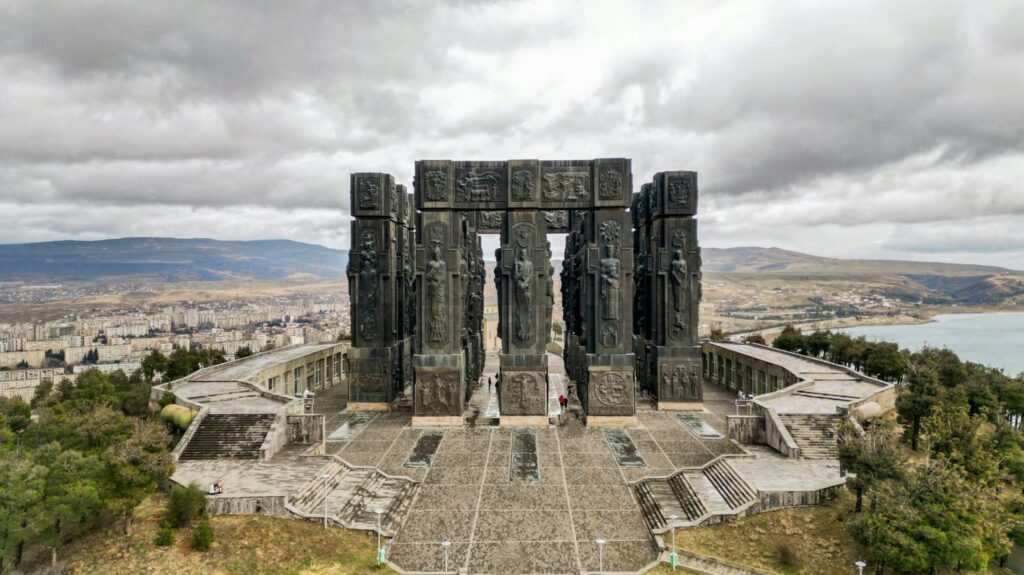
Photo by Haris Khan on Unsplash
The Chronicles of Georgia (also known as the History of Georgia Monument) is an awe-inspiring monumental complex that stands proudly on the Samaia Hill in Tbilisi. Completed in 1985, this striking monument is a unique blend of history, art, and culture, designed to visually narrate the epic tale of Georgia’s rich and turbulent history. The monument is a must-see for anyone wanting to delve into the country’s ancient traditions and legendary past.
🌟 Highlights of the Chronicles of Georgia
• 🏰 Grand Structure
The monument consists of 16 towering stone panels, each depicting key events and figures from Georgia’s history, from the ancient kingdom of Colchis to the medieval period. The monumental columns and intricate stone carvings are designed in a Soviet style, reflecting the monumental ambition of the era in which it was created. Standing tall on the hillside, the structure gives visitors a sense of grandeur and reverence for Georgia’s past.
• 🏞️ Breathtaking Views
Situated on a hill overlooking the city, the Chronicles of Georgia offers one of the best views in Tbilisi. From here, you can see the Kura River, the Narikala Fortress, and the sprawling city below. The scenic location makes it an excellent spot for photographs, especially during sunrise and sunset.
• 🎨 Artistic Depictions
The stone reliefs tell the story of Georgia’s history, mythology, and the major historical figures who shaped the country’s destiny. The monument covers stories of legendary kings, queens, and saints, including figures like King David the Builder, Queen Tamar, and the Christianization of Georgia. The artistry and craftsmanship of the reliefs make it a captivating visual experience for visitors.
• ⛪ Georgian Spiritual Heritage
The monument also features depictions of important religious figures and the spread of Christianity in Georgia. The country has a deeply rooted Christian heritage, and this monument highlights key moments such as the baptism of King Mirian and the vision of Saint Nino.
• 🌳 Surrounding Area
The area around the monument is a peaceful park, perfect for a leisurely walk or to sit and take in the breathtaking views. The surrounding nature provides a sense of calm, making it an ideal place to reflect on the cultural significance of this monumental structure.
🚶 How to Get There
• By Foot:
The Chronicles of Georgia is located on Samaia Hill, a short drive or a moderate walk from Tbilisi city center. For those looking to stretch their legs, walking up through the Tbilisi Botanical Garden and then heading towards the hill offers a scenic and nature-filled approach.
• By Taxi:
A quick and convenient option, taxis are available throughout the city and can take you directly to the monument from most parts of Tbilisi. The ride should take around 10–15 minutes.
• By Car:
If you’re driving, there is limited parking near the monument, but it’s easy to find space in the nearby Botanical Garden or the surrounding streets.
🕒 Visitor Information
• Best Time to Visit:
The Chronicles of Georgia is open year-round, but spring and autumn offer the most pleasant weather for exploring. The monument is especially stunning during sunset when the golden light casts shadows over the stone carvings.
• Opening Hours:
The monument is open 24/7, as it is an outdoor structure. However, visiting during daylight hours offers the best experience to admire the intricate carvings and enjoy the views.
• Entrance Fees:
Free of charge, as it is a public monument. However, donations are appreciated to maintain the site.
• Estimated Duration:
Spending about 30 minutes to 1 hour at the monument is ideal to take in the details of the stone reliefs and the panoramic views.
💡 Travel Tips
• 🕰️ Best Time to Visit:
Visit early in the morning or late in the afternoon to avoid the crowds and experience the monument in the soft light of golden hour. For photography enthusiasts, sunset offers a particularly dramatic setting.
• 📸 What to Bring:
- Comfortable shoes, as you may need to walk uphill or around the park area.
- A camera for the stunning views and intricate carvings.
• 🧳 What to Expect:
- The monument is open-air, so be prepared for exposure to the elements.
- Bring water and a hat if visiting on a hot day, especially during the summer months.
- The walk to the monument can be a bit steep, so be ready for a bit of a climb.
The Chronicles of Georgia is not just a monument; it’s a cultural treasure that encapsulates the spirit and history of Georgia. Whether you’re an admirer of art, history, or simply enjoy beautiful views, this iconic monument is a must-visit. The striking stone reliefs, combined with the serene park surroundings and panoramic vistas, make the Chronicles of Georgia a peaceful yet powerful reminder of the nation’s deep-rooted heritage.
Best Time to Visit Tbilisi
Spring (March to May)
Spring is one of the best times to visit Tbilisi. The weather is mild, with temperatures ranging from 10°C to 20°C (50°F to 68°F), making it ideal for exploring the city on foot. The parks and gardens, especially the Botanical Garden, come alive with vibrant colors, and the crowds are smaller compared to the summer months.
Insider Tip: Spring is also the time for many cultural festivals, including Tbilisi International Film Festival and Tbilisi Jazz Festival.
Summer (June to August)
Summer in Tbilisi can be hot, with temperatures often exceeding 30°C (86°F), but it’s still a great time to experience the city’s energy. Many festivals and events take place during this time, including outdoor concerts and theater performances. The summer months are perfect for those who enjoy longer days and lively outdoor dining.
Insider Tip: If the heat gets too intense, take a break by visiting the Sulphur Baths or head up to Mtatsminda Park for cooler mountain air.
Autumn (September to November)
Autumn is another fantastic time to visit Tbilisi, as the weather is mild and the fall colors paint the city in warm hues. The vineyards around Tbilisi are in full harvest mode, making it a great time for wine lovers to explore Georgia’s famous wine culture. Tbilisi is also less crowded during autumn, allowing for a more peaceful and intimate experience.
Insider Tip: If you’re in Tbilisi during September and October, be sure to join in the grape harvesting season and try traditional Georgian wine-making methods.
Winter (December to February)
Winter is the quietest time in Tbilisi, with fewer tourists and cooler temperatures ranging from 0°C to 8°C (32°F to 46°F). The city looks magical under a blanket of snow, and it’s a perfect time to visit the sulphur baths or enjoy the cozy cafés. However, be prepared for colder weather and shorter daylight hours.
Insider Tip: Tbilisi is located close to the ski resorts in the Caucasus Mountains, so winter travelers can easily take day trips to enjoy skiing and snowboarding.
Final Thoughts
Tbilisi is a city that seamlessly blends the ancient and modern, offering a diverse range of experiences for any traveler. Whether you’re wandering through the cobbled streets of the Old Town, soaking in the stunning views from Narikala Fortress, or relaxing in a sulphur bath, Tbilisi will captivate you with its charm and unique character. No matter when you visit, there’s always something exciting to discover in this vibrant Georgian capital.
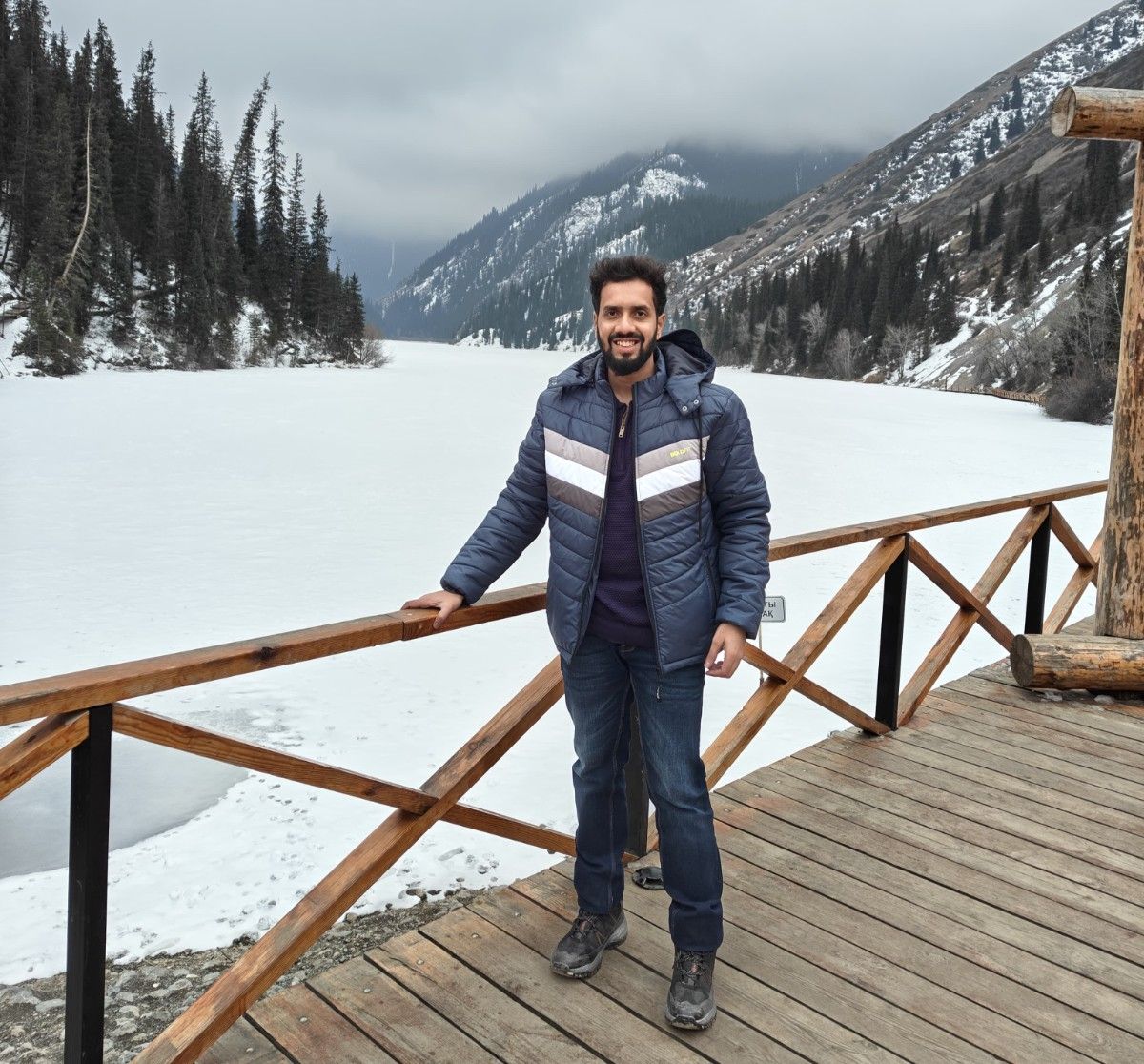
I’m Shreyash Mhashilkar — a full-stack developer by profession, and a passionate explorer of the future at heart.
With a strong foundation in both front-end and back-end , I spend my days building websites and applications that are not just functional, but scalable, intuitive, and user-focused.

